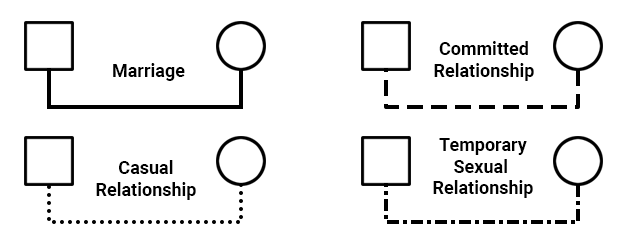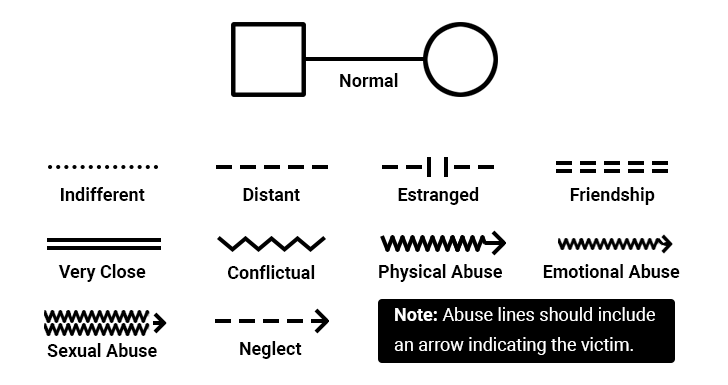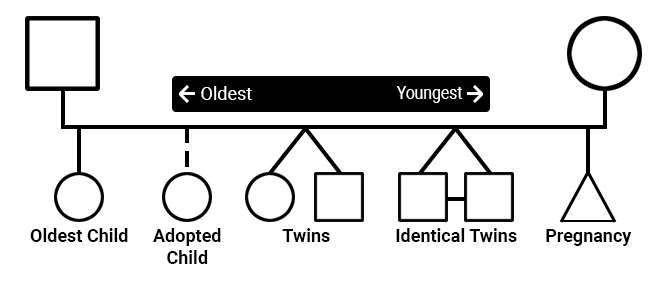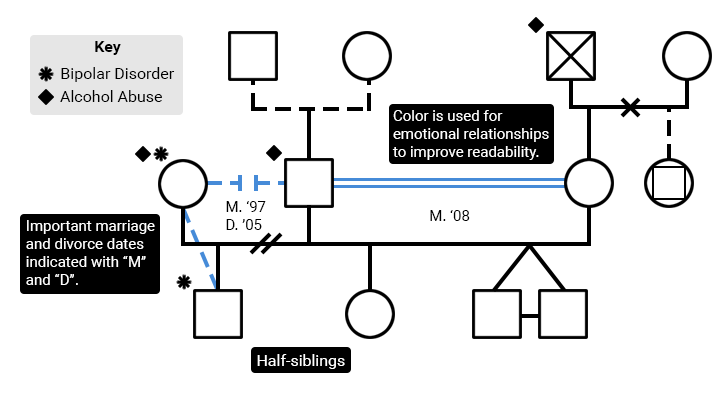Easy Apply Empowerment Counseling Psychotherapy Centerã¢â‚¬â€œ Stoughton
Every generation, families pass a piece of themselves to their kin. The things that are passed down can be beautiful or valuable, like stories, culture, knowledge, and belongings. Or, they can be mostly insignificant, like a cowlick and green eyes from one's grandfather.
Other times, more insidious traits can be passed through generations. Sometimes there's a genetic predisposition to addiction or depression. Other times, unhealthy ways of thinking and behaving are passed down socially, through example.
Genograms provide a way for us to examine these patterns. They bring a family's strengths and weaknesses out into the open. Genograms set the foundation for nurturing generational strengths and overcoming weaknesses.
What is a Genogram?
A genogram is structurally similar to a family tree, but serves a very different purpose. A genogram includes information about relationships and interactions between family members, while a family tree only depicts lineage.
Imagine a genogram as a family tree with much more detail about how the family members interact with one another. For example, a family tree might show us that "Emily and Kevin are married", while a genogram could tell us that "Emily and Ken are married, but they are emotionally distant from one another".
A genogram becomes most valuable when it includes information about several generations. Patterns that are usually hard to decipher seem to jump out once they've been mapped on paper. Maybe you've already noticed a trend of marital trouble in a family's history, but a genogram can highlight the pattern of aloofness and anger that's at the root of those marital problems.
Tip: It's worth noting that genograms are written through the lens of their creator. Everyone will interpret their family's relationships at least a little bit differently, and that's OK. As a clinician, this bias must be taken into account when using genograms during therapy.
How to Create a Genogram
Genograms use a combination of special rules and symbols to depict a lot of information about families as succinctly as possible. Some of these rules and practices have been standardized, and should be followed so future readers can understand your documentation.
Other rules and symbols used in genograms differ depending on who you ask, or what reference you use. It isn't a big deal what symbols you use, as long as you are consistent. This will allow you to look at a genogram from any client—even those you don't know as well—and still glean useful information about their family.
We've also created a genograms symbol sheet for you to keep handy, and to share with clients. We suggest including one of these printouts with any copies of genograms you share with clients.
Tip: Try to include at least three generations when you create a genogram. You can include more generations if they are relevant to treatment, but any less will make the genogram significantly less helpful.
Gender
Men are depicted by a square and women are depicted by a circle.

Family Relationships
Family relationships are depicted by two gender symbols connected by a line beneath them. Men should always appear on the left, and women on the right.

Descriptive symbols, which are placed on top of the family relationship line, give more detail about the relationship's status. Each of these symbols can be placed over any type of line (for example, the "separated" symbol could be placed over the "committed relationship" line or the "marriage" line).

Emotional Relationships
Emotional relationships are depicted with a line directly connecting two gender symbols (different from family relationship connections, where the line is beneath them). These lines can be used to connect any two people on the genogram.
 Tip: Your genograms will be very complicated if you connect every person to everyone else with emotional relationship lines. Try asking about each relationship, but only mark areas that are noteworthy or relevant to treatment.
Tip: Your genograms will be very complicated if you connect every person to everyone else with emotional relationship lines. Try asking about each relationship, but only mark areas that are noteworthy or relevant to treatment.
Children
Children are placed beneath their parents, with a line stemming from the parents' family relationship line. Children should be listed from left to right, oldest to youngest.

Lifespan
Deaths are indicated with an "X" inside the person's symbol. In some cases it may be important to add extra information such as a person's age, or dates related to birth and death.

Additional Information
You can use genograms to depict just about anything that you think might be relevant to treatment. Feel free to create additional markers to fit your needs. For example, you might use an asterisk to indicate "difficulty with anger", or a squiggly line above a gender symbol to indicate "alcohol addiction".
Tip: Include a key whenever you use custom markers. Future you probably won't remember what the jumble of asterisks, squiggles, and diamonds mean.
Putting it All Together
Using the symbols and rules above, you should be able to construct a genogram that any other clinician can pick up and understand. Here's an example of completed genogram along with some commentary.

Using Genograms in Psychotherapy
Assessment
Genograms fit in naturally during the assessment portion of treatment. Not only can genograms provide great information about your client, they can also inform you about family history of mental illness, which can give insight into possible diagnoses.
During family therapy, a genogram can also be used as a way to measure progress. Completing genograms at various points throughout treatment may help you and your clients see when and where there have been improvements to relationships.
Tip: Creating a genogram doesn't have to be a chore. Many people love to talk about their family, and will jump at the opportunity to share a few stories. This is a great opportunity to build rapport and get to know your client at the beginning of treatment.
Individual Therapy
All too often the importance of family is ignored during individual therapy, and genograms are a great way to make sure that your client's roots are not forgotten. In the same way that a person's ethnic or religious culture can shape their thoughts, feelings, and behaviors, so can their family culture. For this reason, clients struggling with a wide range of issues can benefit from learning about their family.
Family Therapy
The use of genograms in family therapy can be tricky because family members may see their relationships very differently from one another. However, these discrepancies can also be very telling. Consider the following example:
Example: A family consisting of two parents (Kori and Jason) and their daughter (Magnolia) come to your office for family therapy. While creating genograms, you notice that the parents both say Magnolia is distant, while Magnolia indicates that her parents are very close to one another, but distant from her.
In this example, it could be hypothesized that Magnolia and her parents both feel excluded from the other's world. Magnolia may feel that her parents care more about one another, yet the parents seem unaware of this. Kori and Jason might benefit from seeing that their daughter isn't just trying to be difficult. Instead, she might be afraid that her parents don't want her around.
Of course, these are just hypotheses. However, this example shows ways in which a genogram can act as a starting point for further exploration, and as a tool for initiating communication between family members.
Don't Forget Strengths
It's easy to get wrapped up in the negative traits that are passed down in families, so don't forget to spend some time on the strengths (especially during family therapy). If every session is spent railing on how dysfunctional a family is, why should they believe things can improve?
Sometimes, even the negative traits in a genogram can have a positive basis. Consider this example:
Example: Katy and her daughter Taylor both reveal through their genograms that they have an anger-fueled relationship with one another, as did Katy and her own mother. Now, Taylor is beginning to rebel.
After further exploration, Katy reveals that she rebelled against her own mother because she couldn't stand the constant lectures. However, Katy says she only lectures Taylor because she wants to help her avoid the same mistakes she made.
In this example, despite some noticeable issues with anger, we also see strengths. Katy is trying to help her daughter, although she seems to be going about it poorly. Her intentions come from a place of love. Focusing only on the anger would be likely to cause further division between Katy and Taylor.
Genograms are a great fit with many types of treatment, and many problem areas. Below, we've included a few references used for this guide, and further reading if you would like to continue learning about this subject.
Source: https://www.therapistaid.com/therapy-guide/genograms
0 Response to "Easy Apply Empowerment Counseling Psychotherapy Centerã¢â‚¬â€œ Stoughton"
Post a Comment